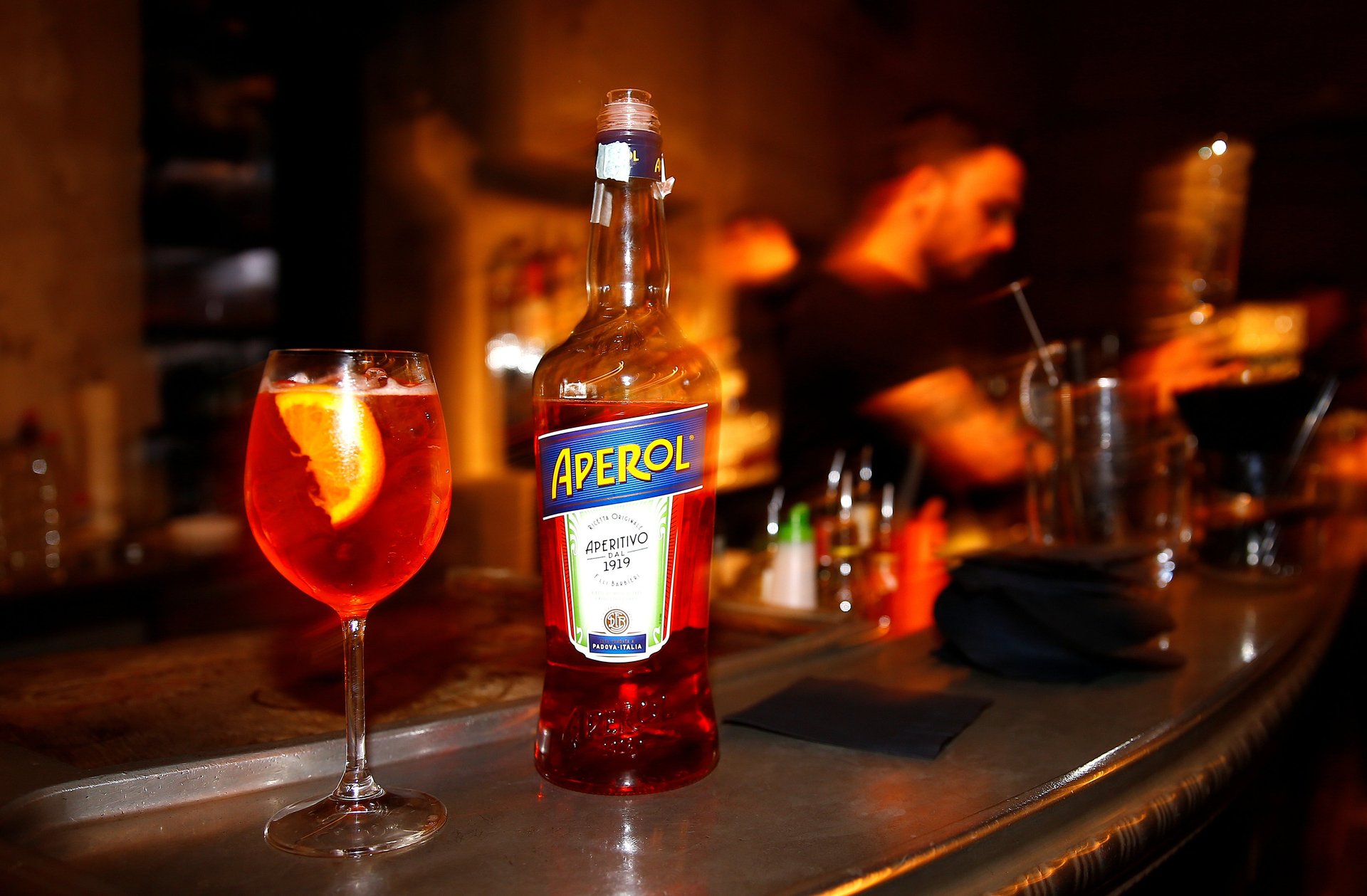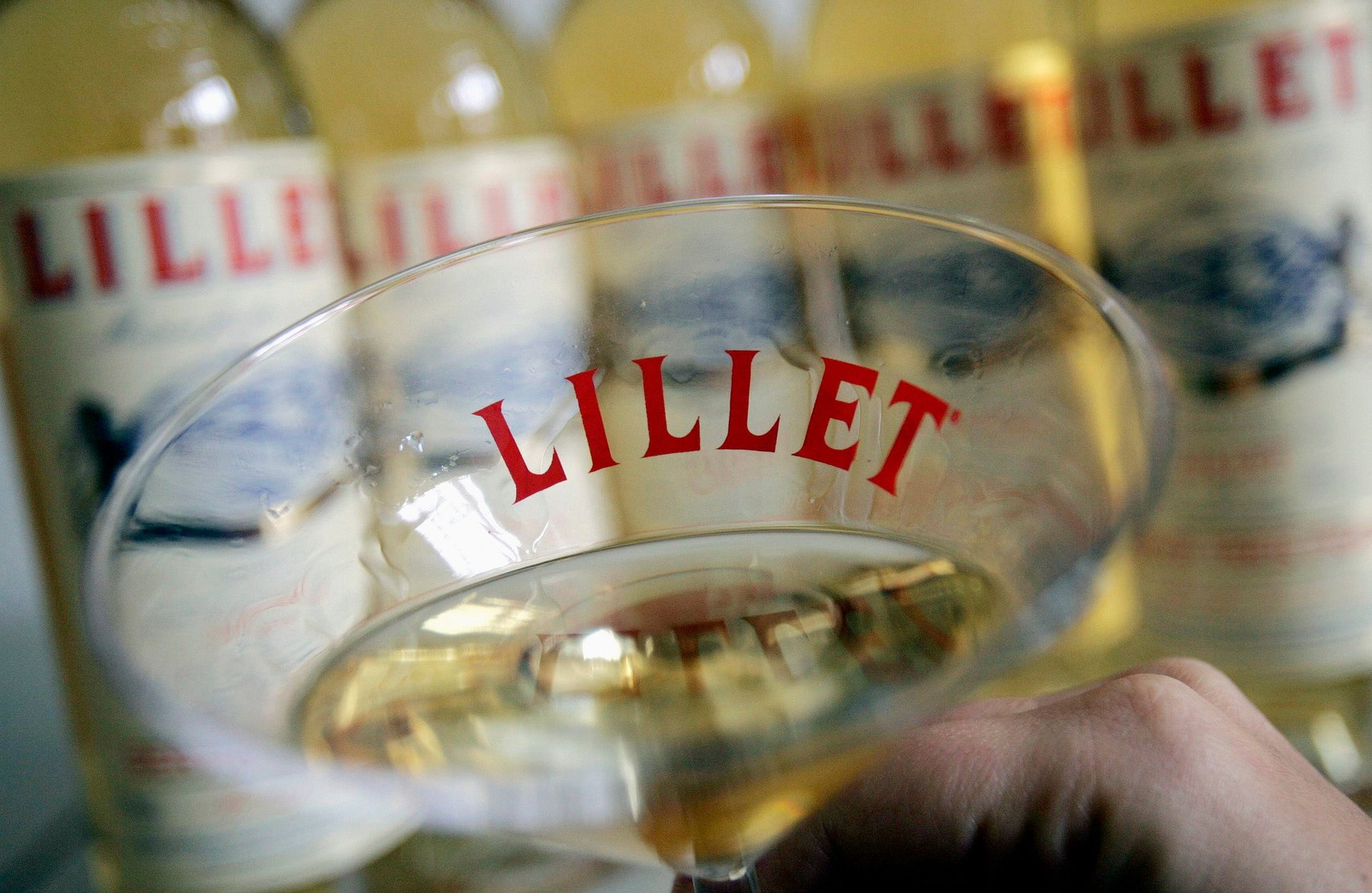As Aperol spritz fatigue sets in, the fight to sell the next big drink is already underway
What comes after the Aperol spritz? The obvious response—”Another Aperol spritz!”—is beginning to seem a little less obvious.


What comes after the Aperol spritz? The obvious response—”Another Aperol spritz!”—is beginning to seem a little less obvious.
After years of popularity throughout Europe, the cocktail finally cracked the US in 2017, with year-on-year sales of its base spirit, the Italian liqueur Aperol, rising 48%. By 2018, the Aperol spritz was being called the drink of the summer, snapped again and again and again, on boats and beaches alike. Along the way, the share price of Aperol’s parent company, the Campari Group, bubbled up from $2.56 to a peak of about $12 earlier this year.
In less than a decade, this sparkling orange drink, made with a slug of liqueur, topped up with prosecco and soda, has shot from relative obscurity to near-ubiquity. The base spirit, once a niche product, is now the Campari Group’s largest seller.
But something resembling Aperol spritz fatigue is starting to settle in. In a pure shots-fired move, the New York Times officially deemed it “not a good drink” earlier this year, comparing it to a kids’ juice box. Since May, parent company Campari’s share price has drifted down by about 15%. The drink that launched a million sunset selfies suddenly tastes a little flat.
If its popularity continues to wane, the door is open for next summer’s slam hit—the Aperol spritz’s successor. But what will it be? “Everybody is trying to get a piece of the pie,” says Talia Baiocchi, the editor of the digital drinks magazine Punch and author of Spritz, a history of the drink. At least for the time being, “Aperol is the owner of that pie.”
Lower alcohol aperitifs make up a tiny fraction of the global beverage industry—they represent about 2% of all spirits sales, or around $500 million a year—but one enjoying healthy growth, powered by the popularity of Aperol. Should the Aperol spritz slump into disfavor, its former drinkers may instead return to their old habits of harder spirits-and-mixers, wine, or beer, blunting the momentum of a small but lively corner of the drinks world.
For drinks marketers, the challenge is twofold: first, they must figure out what the next drink of the moment might be; next, they must find a way to communicate to consumers that this new drink, whatever it is, is what they were looking for all along. Many of the more promising candidates seem to touch upon some element of the Aperol spritz: its of-the-moment low alcohol-by-volume (ABV), its notes of herbaceous bitterness, or its eye-popping shade. The extremely smart marketing campaign, which included free Campari merch and luminous livery at distinctive hot locations, is also a model—and may have been at least as important as in its success as how it actually tastes.
When next summer’s consumers find themselves reaching for colored gin and tonics, or Lillet spritzes, or any other worthy contender, it shouldn’t be obvious which levers have been pulled to get them to the point of purchase. As the old advertising adage goes, no one likes to be sold to, but everyone likes to buy.
The “aperitivo moment”
For drinks companies, the most obvious starting point is not what customers are drinking, but when.
Over the past decade, thousands of US nightclubs have shuttered annually, with millennials choosing to meet partners online. If you’re selling booze, that’s a significant consideration—the drink order shouted across the bar at 2am is likely to differ from the go-to on a sunny weekend afternoon. Now, it’s the “aperitivo moment” that drives sales, says Ed Pilkington, the chief marketing officer for beverage giant Diageo.
Drinks that work best here are “lightly effervescent,” and generally refreshing, says Pilkington—think gin and tonic, or Prosecco. (Spiked seltzer fits, too.) Many also have a relatively low alcohol content, appealing to health conscious drinkers, or people looking to keep their wits about them. The Aperol spritz was an obvious candidate.
Beyond pushing the gin and tonic, Diageo’s own answer to these trends is its range of Ketel Botanicals, released last year. Unlike most alcohol brands, its marketing material touts its health credentials—no carbs, 30% alcohol by volume, and only 73 calories per serving. Somewhere between a gin and a flavored vodka, it’s designed to be mixed with seltzer and served in a wine glass with a fancy garnish.
Despite significant coverage of the “sober curious” trend, it hasn’t made much of an impact on alcohol sales, says Pilkington. “Overall, drinking is pretty much flat in terms of the amount of alcohol that’s being consumed.”
But growing health-consciousness has led to greater enthusiasm for drinks with lower ABV and calories. (In some cases, this is more about signaling one’s healthy ambitions: Aperol’s 11% ABV becomes less relevant once it’s mixed with Prosecco and served in a wine glass as large as a fishbowl.)
Same same, but different
My colleague Jenni Avins would tell you that the Aperol spritz is a gateway: a perfect starting place for intrepid drinkers to quickly reach more interesting alternatives. If she’s right, and people really want the spritz 2.0, it’s great news for the Campari Group.
For most US or UK drinkers, the spritz is Aperol, mixed with prosecco and soda, per the instructions on the label. But in Italy, and elsewhere in continental Europe, “spritzes” have a much wider connotation. “The spritz was not a recipe until Aperol decided to put it on the back of their bottle,” says Baiocchi. “It was a manner of serving wine at a specific time of day in this part of Northeastern Italy. It was really Aperol that went and codified that and marketed it.”
If Campari can convince American drinkers to think of the spritz as a category, rather than a drink, it may be in a good place to push other, more unloved products. The Italian company has almost an entire shelf of potential Aperol replacements, each ripe for spritzification.
Various plays on the Amaro spritz, for instance, balance its bitter herbal notes with a twist of lime; a juniper edge may appeal to gin-happy consumers who’ve had enough of tonic. The Braulio spritz is more pine-forward. Other Campari Group alternatives which play well with fizzy water and a splash of Prosecco include artichoke-based Cynar, or the cola-flavored Fernet, favored in Argentina. The most obvious replacement is the eponymous Campari: same citrus notes, same gorgeous hue, same slight bitterness.
Retro stylings?
Aperol was acquired by the Campari Group in 2003, almost a century after its 1919 launch. Though the bottle’s label has gone through multiple iterations, it retains the same vintage feel and art nouveau sensibility of the original.
Certain canny competitors, therefore, have plunged deep into their back catalog to find their own answer to grandma-chic.
The French drinks giant Pernod Ricard is hedging its bets on Lillet, a wine-based aperitif the brand acquired in 2018. Relatively unknown outside of its native France, where it has long been thought of as pleasantly kitsch, it is traditionally served over ice. Now, however, the brand is pushing the Lillet Vive, “spritzified” with tonic water. Founded in 1872, it has the same old-school whimsy as Aperol, albeit with a sweeter, more floral flavor profile (and a far less Insta-friendly color). More recent iterations, including the brightly colored Lillet Rouge and Rosé, meanwhile, offer more photogenic versions of the drink.

So far, the Lillet marketing campaign bears striking similarity to Campari’s recent efforts around the world to make Aperol the next big thing. In Germany and Poland, the Lillet logo is emblazoned on wine glasses; in France, the brand has purchased multiple full-page ads in glossy women’s magazines. In the US, the focus seems to be micro-influencer sponsorship across blogs and Instagram. Throughout July, London’s open-air Oxo Terrace Bar played host to a “Lillet French Oasis,” festooned with roses. Similar campaigns, often featuring cutesy striped deckchairs, have been rolled out in South Korea, Russia, and Spain, among other countries.
The company has also nudged Dubonnet, the preferred drink of UK queen Elizabeth II, into the spotlight, with a late 2018 bottle redesign, and sponsored content with the digital drinks magazine Punch.
Like Aperol, many of these have a lower ABV than gin, whisky, and most other brown or white spirits. Dubonnet comes in at 19% in the US and 14.8% in France; at 17% ABV, Lillet is similarly unboozey.
Some of these older brands, says Baiocchi, aren’t going for the spritz at all: ”They’re saying, ‘Well, look, Dubonnet was a part of these historic low ABV cocktails that emerged a bit before and after and even during Prohibition.'” Your grandmother’s favorite tipples may now play into a renewed desire for drinks with a little less wallop.
The great unknown
The Aperol spritz is a mixed drink—six parts Prosecco; four parts Aperol; a splash of seltzer, coming together to form a bubbly, distinctive drink the color of the hot filament of an incandescent bulb. There’s every indication that its success may also be a finely-balanced cocktail—right components, right moment, right marketing strategy. (There are other, less tangible factors: it reminds a lot of people of European beachside holidays, and the word “spritz” is very fun to say.)
What if all these efforts are a waste of time, and the Aperol spritz’s success can’t be replicated any time soon?
It’s very unusual for any mixed drink to be a viral sensation on this level, explains Baiocchi. “Everyone’s probably wondering what [modern cocktail] could potentially be the next Aperol spritz. But I feel like it comes around once every 30 to 40 years.”
She gives the example of the Cosmopolitan, the rose-colored, vodka-based drink that became near-ubiquitous in the 1980s and 1990s. “It had a hell of a lot of help from pop culture,” she adds—most notably through cable television and the women of HBO’s Sex & the City franchise, who stopped ordering it because, in the words of Carrie Bradshaw, “everyone else started.” The Aperol spritz had social media instead. “It’s hard to take a bad picture of that drink,” says Baoicchi, who describes it as built for Instagram before the platform even existed. “It’s a part of their tagline—the ‘sunset in a glass.'”
Perhaps the formula is this: a visually striking drink disseminated via new media equals viral sensation. The next big mixed beverage may be decades away—when it comes, its success might rely on TikTok or Famous Birthdays or some other next-generation platform. It seems more likely, however, that it’s sufficiently far away that, when it arrives, it’ll achieve global domination through a form of media that doesn’t even exist yet. A whole other challenge for even the most forward-thinking of marketing teams.
In the meantime, perhaps we’ll have to make do with White Claw.